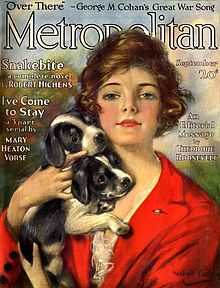Metropolitan Magazine (New York)
 Metropolitan Magazine, cover dated September 1917 | |
| Categories | Politics, literature, art |
|---|---|
| Circulation | Monthly |
| First issue | 1895 |
| Final issue | August 1925 |
| Country | United States |
| Language | English |
Metropolitan Magazine, known in its later years as Macfadden's Fiction Lover's Magazine, was a monthly periodical in the early 20th century with articles on politics and literature.
History
Metropolitan Magazine began in 1895 as a sophisticated magazine for theater-goers in New York.[1] During World War I the publication focused on politics and literature.[1] Its first editor and publisher was John Brisben Walker.[2] In 1902, the magazine was sold along with The Daily Telegraph for $100,000 to Col. George Harvey, president of Harper & Brothers.[3] Harvey said, "in purchasing The Metropolitan I bought simply a name," and that the chief mission of the periodical should be urban life in New York.[3] He named John Kendrick Bangs as the new editor.[3]
The Mexican Revolution and World War I
During the Mexican Revolution, Metropolitan Magazine sent John Reed to Mexico to report.[4] The journalist met Pancho Villa and stayed with his troops for four months.[4] Reed was sent to Europe as a war correspondent during World War I.[4] However, some of his articles were rejected as having leftist sympathies.[4]
Metropolitan Magazine frequently contained articles critical of United States President Woodrow Wilson during World War I. In 1918, the New York postmaster was told to be on his guard for issues of the magazine commenting on Wilson's foreign policy.[5] There were rumors that the post office was considering revoking the publication's second class mail privileges.[5] However, all issues of the magazine were delivered.[5]
In 1914, former United States President Theodore Roosevelt became an editor for the magazine for $25,000 a year.[6] He took a three-year contract because he intended to retire from politics and writing.[6] However, during World War I Roosevelt wrote many essays criticizing President Wilson for his handling of the war.[6] Roosevelt passionately argued against the neutrality of the United States, writing, "We earn as a nation measureless scorn and contempt if we follow the lead of those who exalt peace over righteousness, if we heed the voice of those feeble folk who bleat to high Heaven for peace when there is no peace."[7] Roosevelt worked on editorial articles for Metropolitan Magazine until his death.[8] His last action was to write a letter to his son with the proofs for his last article in the magazine.[8]
Decline
In January 1923, on the urging of Supervising Editor Fulton Oursler, Bernarr Macfadden bought the magazine, launching its new era with an abridged serialization of Theodore Dreiser's banned novel The Genius. The first Macfadden issue was dated February-March 1923. It then reverted to a monthly. Fulton Oursler's first serious novels, Behold This Dreamer! and Sandalwood were also serialized. When the magazine's fortunes didn't improve, the title was changed to Macfadden Fiction-Lovers Magazine with the October 1924 issue.[2][9] Its last issue was in August 1925.[2]
Famous contributors
- Theodore Dreiser[10]
- Edna Ferber[11]
- F. Scott Fitzgerald[11]
- Katharine Fullerton Gerould[11]
- Jack London[1]
- Clarence E. Mulford[12]
- John Reed[4]
- Theodore Roosevelt[6]
See also
References
- ↑ 1.0 1.1 1.2 Walker, Dale. "Why this longing for life? It is a game which no man wins". Jack London: The Stories. Retrieved 2009-04-08.
- ↑ 2.0 2.1 2.2 "Magazine Issues". Galactic Central. Retrieved 2009-04-08.
- ↑ 3.0 3.1 3.2 Distin, William (December 6, 1902). "Plans for two publications" (PDF). The New York Times. Retrieved 2009-04-08.
- ↑ 4.0 4.1 4.2 4.3 4.4 Liukkonen, Petri. "John Reed". Retrieved 2009-04-08.
- ↑ 5.0 5.1 5.2 "Magazine Wasn't Barred From Mails" (PDF). The New York Times. March 10, 1918. Retrieved 2009-04-08.
- ↑ 6.0 6.1 6.2 6.3 Lansford, Tom (2005). Theodore Roosevelt in perspective. Nova Publishers. p. 133. ISBN 1-59454-656-8. Retrieved 2009-04-08.
- ↑ Bishop, Joseph Bucklin (1920). Theodore Roosevelt and His Time Shown in His Own Letters. C. Scribner's Sons. p. 378. Retrieved 2009-04-08.
- ↑ 8.0 8.1 "Embolism Caused Death" (PDF). The New York Times. January 7, 1919. Retrieved 2009-04-08.
- ↑ "Metropolitan Magazine". MagazineArt.org. November 17, 2006. Retrieved 2009-04-08.
- ↑ McDonald, Edward David (1928). A bibliography of the writings of Theodore Dreiser. Ayer Publishing. p. 95. ISBN 0-8337-2328-6. Retrieved 2009-04-08.
- ↑ 11.0 11.1 11.2 "Miscellaneous Anthologies". Galactic Central. Retrieved 2009-04-08.
- ↑ Nevins, Francis M., Jr. (1993). Bar-20: The Life of Clarence E. Mulford, Creator of Hopalong Cassidy. Jefferson, North Carolina: McFarland. pp. 2–3. ISBN 0-89950-870-7.